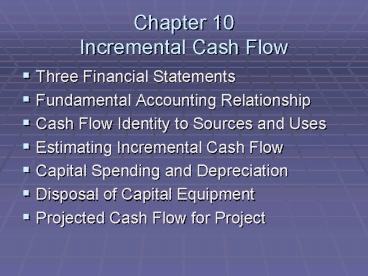Chapter 10 Incremental Cash Flow PowerPoint PPT Presentation
1 / 14
Title: Chapter 10 Incremental Cash Flow
1
Chapter 10Incremental Cash Flow
- Three Financial Statements
- Fundamental Accounting Relationship
- Cash Flow Identity to Sources and Uses
- Estimating Incremental Cash Flow
- Capital Spending and Depreciation
- Disposal of Capital Equipment
- Projected Cash Flow for Project
2
Three Financial Statements
- Income Statement Measure of performance over a
specific time - Statement of Financial Position or Balance Sheet
Listing of all assets, liabilities, and
ownership claims - Sources and Uses of Cash or Statement of Cash
Flow Where dollars came from and where dollars
were spent
3
Three Financial Statements
- Income Statement bottom line is net income
- Net income is not cash flow
- Accrual Accounting timing of cash and recording
of economic transaction different - Noncash items depreciation for example
- Want operating cash flow (OCF)
- Use modified income statement
- Interest expense is not part of OCF
4
Three Financial Statements
- The Balance Sheet Categories
- Cash Account
- Key element is change in cash over the period
- Cash includes money, checking accounts, etc.
- Working Capital Accounts
- Current Assets and Current Liabilities
- Assets and Liabilities typically converted to
cash or paid over the business cycle - Long-Term Debt
- Owners Accounts
- Snapshot of company at a specific point in time
5
Three Financial Statements
- Statement of Cash Flow or Sources and Uses of
Cash - Cash flow from business operations
- Cash flow from financing
- From Owners (residual claims)
- From Lenders (fixed claims)
- Cash flow for capital spending
- Purchase of capital equipment
- Recapture cash from sale of assets
- Ties to the change in Cash Account over the period
6
Fundamental Accounting Relationship
- Accounting Identity in two forms
- Assets Liabilities Owners Equity
- Cash Flow from Assets Cash Flow to Creditors
Cash Flow to Owners - Building the Cash Flow Identity
- Cash Flow from Assets Operating Cash Flow
Increases in Net Working Capital Increases in
Capital Spending - Work through components, pages 269-271
7
Fundamental Accounting Relationship
- Continued Building the Cash Flow Identity
- Cash Flow to Creditors
- Interest paid on debt shows up in this section
not in operating cash flow - Any repayment of principal on debt claims
- Cash Flow to Owners
- Dividend Payments
- Any retirement of common stock
- Increases in debt or common stock are cash flow
from owners or creditors
8
Cash Flow Identity to Sources and Uses of Cash
- Once the components of the cash flow identity are
calculated - Convert the information into the Statement of
Cash Flow or Sources and Uses of Cash - The change in the cash account is the bottom
line of this statement - Three Categories
- Operating Activities
- Investing Activities
- Financing Activities
9
Estimating Incremental Cash Flow
- Objective Estimate future cash flow of a
project (for decision making) - Only Incremental Cash Flow used in decision
- Sunk Costs Do not use
- Erosion Costs Must account for lost sales of
old products when new product introduced - Working Capital new projects require working
capital, must include in cash flow - Capital Expenditures Usually large up front
cash flow out - Depreciation and cost recovery on divesting assets
10
Capital Spending and Depreciation
- Capital Spending for a project is usually an up
front cash outflow - It is expensed on the income statement over time
via depreciation - Depreciation is not a cash flow
- Deprecation impacts cash flow through reduction
in taxes, a real cash flow - Different Types
- Straight line depreciation
- Modified Accelerated Cost Recovery System (MACRS)
11
Capital Spending and Depreciation
- Depreciation example for Cogswell Cola
- Bottling Machine Initial cost is 1,500,00
- Include installation costs, another 150,000
- Property class for MACRS is 7 years
- Annual depreciation expense
- Year 1 1,650,000 x 0.1429 235,785
- Year 2 1.650,000 x 0.2449 404,085
- Year 8 1,650,000 x 0.0445 73,425
- Table 10.7 for all eight years
12
Disposal of Capital Equipment
- When a capital asset is disposed of by a company
it can result in cash flow - Fully depreciated assets, sale price minus taxes
paid on gain on sale - When asset is not fully depreciated
- Determine current book value of asset
- Difference between sales price and book value is
the gain or loss on disposal - Tax a gain and tax credit on a loss
- Cash flow is sales price tax or sales price
credit - Example 10.3 College Doughnuts Disposal
13
Projected Cash Flow for Project
- Putting all the elements together on incremental
cash flow for decision making on a project - Initial Investment (typically capital spending
and increases in working capital) - Annual operating cash flow
- Disposal of equipment
- Decrease in working capital at conclusion of
project - Use Incremental Cash Flow with
- NPV Model
- IRR Model
- Example Bottle Water Project Table 10.12
14
Problems
- Problem 1 Balance Sheet Accounts
- Problem 3 Operating Cash Flow
- Problem 5 Income Statement
- Problem 6 Cash Flow from Assets
- Problem 7 Cash Flow to Creditors
- Problem 8 Cash Flow to Owners
- Problem 9 Cash Flow Identity
- Problem 11 Erosion Costs
- Problem 15 Depreciation Costs

